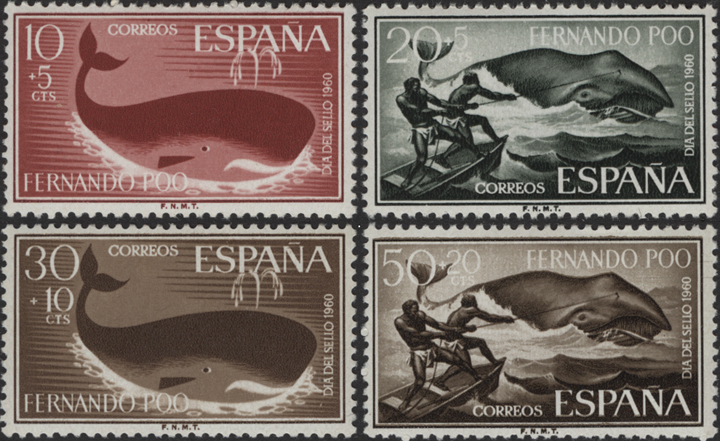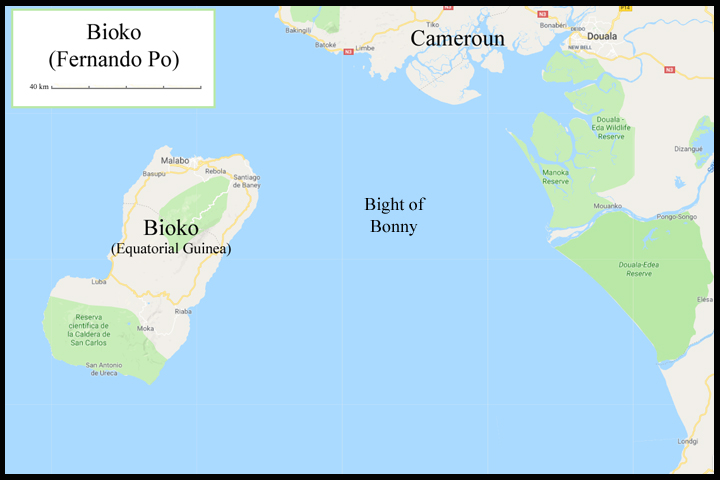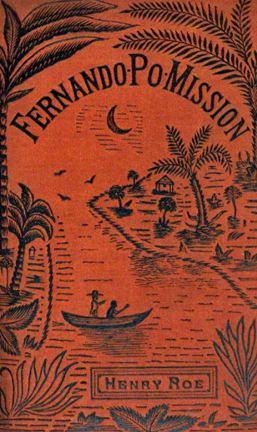Fernando Po
Stamp Day Semi-Postals of 1960

Fernando Po's stamp day semi-postals of 1961 depict a whale and whalers in small boats harpooning a whale.
Fernando Po, now called Bioko, is an island in the Bight of Bonny that was discovered by the Portuguese in 1472. Along with the mainland territory of Rio Muni it was, until 1960, part of Spanish Guinea. Spain had acquired the island from Portugal in 1778 and from 1827-1834 it was leased by the British as a base for anti-slavery operations. Although the base was closed, the island remained a centre of British activity and the use of British stamps was authorized between 1858 and 1877; in 1859 the British Consul became the British Packet Agent. Fernando Po's first stamps, depicting Isabella II of Spain, were issued in 1868. These stamps were replaced by those of Spanish Guinea in 1909 (except for one special issue in 1929). After 1960 separate postal issues for Fernando Po resumed; seventy-five regular stamps and thirteen semi-postals were released. Although many of the stamps depict African flora and fauna and aspects of indigenous culture, others emphasize cultural connections with Spain. On October 12, 1968 it rejoined Rio Muni to form Equatorial Guinea whose stamps are now used.
In 1861, a correspondent from The New York Times writing from the U.S.S. Saratoga reported on the importance of the island to ships in the area:
Were it not for the monthly arrival of the mails, I can hardly think of anything to call a vessel to this port. But the expectation of our letters makes Fernando Po a desirable stopping place about the 27th of each month.
He provides some details to justify his unfavourable evaluation of the island:
Fernando Po, I'll venture to assert, possesses as many of the requisites for forming an uncomfortable disagreeable place, as any other locality in the world. The anchorage is off Port Clarence, on the northern face of the island, and is, except for a short period each day during the sea breeze, intolerably hot. The town, with the exception of the Governor's house, the barracks, and a few foreigners' residences, is but a collection of shanties. The place is owned by the Spaniards, who maintain a few companies of soldiers and a couple of hulks afloat. There is but little commerce -- the exports consisting of palm oil, coffee and dye woods. I saw cotton growing, but am not able to give any opinion as to its quality. There is no market, and it was with difficulty that we could procure a few yams for our mess.
In his account of his arrival in Fernando Po in February 1870, missionary Henry Roe also documents how the mail ships announce their arrival:
It is 4 a.m. and we are steaming into Santa Isabel harbour, cheered by eight lights on shore. To announce the arrival of the British Mail, the ship's cannon is fired, and is answered by a rolling echo around the mountain sides, and the melancholy yelling of dogs, and the crowing of cocks.
Roe continues to describe the island with a cosmopolitan population consisting of a small Spanish community of fifty (half of whom live on a ship in the harbour), African labourers and liberated slaves from other parts of the continent and the indigenous Bubi. He also describes the scene from his verandah where, in addition to mail steamers and canoes paddled by natives, he observed "in their own proper month ... many whales 'blowing up water like steam engines.'"
This gives context to Fernando Po's stamp day issue of 1960; it depicts a whale in one design and whalers harpooning a whale in the second design. Although there has been considerable whaling activity in the south Atlantic off Africa's west coast, Fernando Po does not appear to have been a significant centre of activity. The exception would be the 1913-1914 season when about 1760 humpback whales were taken off Fernando Po and the French Congo by Norwegian whalers. In preceding and subsequent years there are occasional references to French Congo but not Fernando Po in the reports of the committee for whaling statistics. It may be that local whaling activities did fall within the scope of international statistics or that the whale sightings that were so commonplace in Henry Roe's time declined to relative insignificance from a commercial point of view.

Fernando Po is located in the Bight of Bonny in the Gulf of Guinea.

In 1882 missionary Henry Roe reported on his experiences
in Fernando Po beginning in February 1870.
Bibliography
"Fernando Po." Standard Postage Stamp Catalogue. 2015.
"Fernando Po." Wikipeida: The Free Encyclopedia. Wikimedia Foundation, Inc.
10 Aug. 2017. Web. https://en.wikipedia.org/wiki/Fernando_Po.
"FROM THE AFRICAN COAST." The New York Times. 14 Jan. 1862: np. Web.
29 Jan. 2018. http://www.nytimes.com/1862/01/14/news/african-coast-kroomen-
kroomen-what-they-can-their-social-characteristics-fernando-po.html?pagewanted=all.
"Portrait of Pablo de Valladolid." Wikipeida: The Free Encyclopedia. Wikimedia Foundation, Inc.
23 Dec. 2016. Web. https://en.wikipedia.org/wiki/Portrait_of_Pablo_de_Valladolid.
Roe, Henry. Fernando Po Mission. London: Elliot Stock, 1882. Web. 30 Jan. 2018.
https://books.google.ca/books?id=7SKgHAAACAAJ&dq=Fernando+Po+Mission
&hl=en&sa=X&ved=0ahUKEwjr8uST5YTZAhWBTN8KHbSPCsgQ6AEILjAB.
Rossiter, Stuart and John Flower. The Stamp Atlas. London: Macdonald and Co., 1986.
Direct comments, questions and corrections to:
stampquestions@hotmail.com
© Grose Educational Media, 2018
|